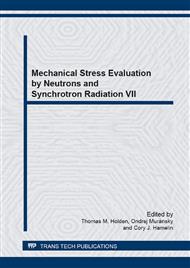[1]
E. Kraft, Summary of Emerging Titanium Cost Reduction Technologies, (EHK Technologies-for ORNL, Vancouver, WA, 2004), 1-59.
Google Scholar
[2]
C.A. Brice, B.T. Rosenberger, S.N. Sankaran, K.M. Taminger, B. Woods, R. Nasserrafi, Chemistry control in electron beam deposited titanium alloys`, Materials Science Forum, 618-619 (2009) 155-158.
DOI: 10.4028/www.scientific.net/msf.618-619.155
Google Scholar
[3]
S. Seong, O. Younossi, B.W. Goldsmith, Titanium: Industrial Base, Price Trends, and Technology Initiatives, RAND Corporation, Santa Monica, California, 2009.
DOI: 10.7249/mg789
Google Scholar
[4]
B. Baufeld, O.V.d. Biest, R. Gault, Additive manufacturing of Ti–6Al–4V components by shaped metal deposition: Microstructure and mechanical properties, Materials & Design, 31, Supplement 1 (2010) S106-S111.
DOI: 10.1016/j.matdes.2009.11.032
Google Scholar
[5]
G. Escobar-Palafox, R. Gault, K. Ridgway, Robotic manufacturing by shaped metal deposition: State of the art, Industrial Robot, 38 (2011) 622-628.
DOI: 10.1108/01439911111179138
Google Scholar
[6]
F. Wang, S. Williams, P. Colegrove, A. Antonysamy, Microstructure and Mechanical Properties of Wire and Arc Additive Manufactured Ti-6Al-4V, Metallurgical and Materials Transactions A, 44 (2013) 968-977.
DOI: 10.1007/s11661-012-1444-6
Google Scholar
[7]
C. Charles, in: Division for Material Mechanics - Department of Applied Physics, Lulea University of Technology, Lulea, 2008.
Google Scholar
[8]
J. Ding, P. Colegrove, J. Mehnen, S. Ganguly, P.M. Sequeira Almeida, F. Wang, S. Williams, Thermo-mechanical analysis of Wire and Arc Additive Layer Manufacturing process on large multi-layer parts, Computational Materials Science, 50 (2011) 3315-3322.
DOI: 10.1016/j.commatsci.2011.06.023
Google Scholar
[9]
P.A. Colegrove, H.E. Coules, J. Fairman, F. Martina, T. Kashoob, H. Mamash, L.D. Cozzolino, Microstructure and residual stress improvement in wire and arc additively manufactured parts through high-pressure rolling, Journal of Materials Processing Technology, 213 (2013) 1782-1791.
DOI: 10.1016/j.jmatprotec.2013.04.012
Google Scholar
[10]
C. Brice, W. Hofmeister, Determination of Bulk Residual Stresses in Electron Beam Additive-Manufactured Aluminum, Metallurgical and Materials Transactions A, (2013) 1-7.
DOI: 10.1007/s11661-013-1847-z
Google Scholar
[11]
A.K. Swarnakar, O. Van der Biest, B. Baufeld, Thermal expansion and lattice parameters of shaped metal deposited Ti–6Al–4V, Journal of Alloys and Compounds, 509 (2011) 2723-2728.
DOI: 10.1016/j.jallcom.2010.12.014
Google Scholar
[12]
J.A. James, J.R. Santisteban, L. Edwards, M.R. Daymond, A virtual laboratory for neutron and synchrotron strain scanning, Physica B: Condensed Matter, 350 (2004) E743-E746.
DOI: 10.1016/j.physb.2004.03.194
Google Scholar
[13]
S. Ganguly, J.A. James, M.E. Fitzpatrick, A. Tanguy, Automation of a neutron diffractometer for analysis of residual stress inside complex engineering components, Applied Physics A: Materials Science and Processing, 99 (2010) 601-606.
DOI: 10.1007/s00339-010-5615-2
Google Scholar
[14]
T. Manns, B. Scholtes, DECcalc - A Program for the Calculation of Diffraction Elastic Constants from Single Crystal Coefficients, Materials Science Forum, 681 (2011) 417-419.
DOI: 10.4028/www.scientific.net/msf.681.417
Google Scholar
[15]
Struers, B. Taylor, E. Weidmann. http://www.struers.com/resources/elements/12/104827/Application_Note_Titanium_English.pdf. cited October 2; 2009.
Google Scholar


